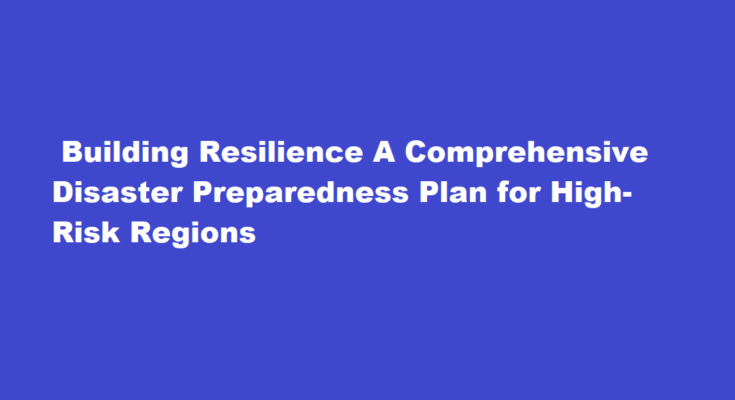Introduction
High-risk regions prone to natural calamities face the constant threat of devastating disasters, such as earthquakes, floods, hurricanes, and wildfires. In such areas, developing a comprehensive disaster preparedness plan is essential to safeguard lives, protect infrastructure, and reduce the impact of these catastrophic events. This article will outline the key steps involved in creating a unique and informative disaster preparedness plan to build resilience and respond effectively to emergencies in high-risk regions.
Risk Assessment and Hazard Mapping
The first step in developing a disaster preparedness plan is to conduct a thorough risk assessment and hazard mapping exercise. Collaborate with experts, local authorities, and community stakeholders to identify the potential natural hazards prevalent in the region. Create hazard maps that highlight vulnerable areas, such as floodplains, fault lines, or wildfire-prone zones. Understanding these risks will allow for targeted and strategic planning.
Establishing Early Warning Systems
An efficient early warning system is critical for providing timely information to communities and authorities about impending disasters. Leverage technology and community networks to establish alert systems that can quickly disseminate warnings via text messages, sirens, social media, and other communication channels. Regular drills and simulations will help familiarise residents with the procedures to follow during emergency situations.
Community Engagement and Education
A disaster preparedness plan is only effective when the community actively participates in its implementation. Conduct workshops, training sessions, and public awareness campaigns to educate residents on disaster preparedness, evacuation routes, and emergency protocols. Encourage community members to create their disaster supply kits and devise family emergency plans.
Building Resilient Infrastructure
Developing infrastructure with disaster resilience in mind is crucial for mitigating the impact of natural calamities. Work with engineers and urban planners to incorporate seismic-resistant building codes, flood-proof construction techniques, and fire-resistant materials in new developments and retrofit existing structures. Additionally, ensure critical infrastructure such as hospitals, schools, and emergency services are located in safe areas and built to withstand disasters.
Establishing Emergency Response Teams
High-risk regions require dedicated and well-trained emergency response teams to handle disaster situations effectively. These teams should consist of first responders, medical personnel, search and rescue units, and volunteers. Regular drills and training exercises should be conducted to ensure their preparedness and coordination during emergencies.
Creating Evacuation Plans
Developing efficient evacuation plans is essential for high-risk regions. Identify safe evacuation routes and establish designated assembly points for residents to gather during evacuations. Collaborate with public transportation authorities to integrate evacuation strategies into existing systems and ensure the transportation needs of vulnerable populations are met.
Disaster Recovery and Relief Measures
A comprehensive disaster preparedness plan should also encompass strategies for disaster recovery and relief measures. Collaborate with local and national agencies, NGOs, and international organisations to establish a coordinated response in providing aid, food, water, medical assistance, and shelter to affected communities.
Harnessing Technology and Data Analytics
Utilise technology and data analytics to improve disaster preparedness and response efforts. Satellite imagery, weather forecasting, and real-time data analysis can aid in predicting and monitoring natural disasters. Implement geographic information systems (GIS) to map vulnerable areas and optimise emergency response operations.
FREQUENTLY ASKED QUESTIONS
What are the components of a comprehensive disaster preparedness strategy?
Comprehensive Disaster Management (CDM) is an integrated approach to disaster management. It is viewed as the management of all hazards through all phases of the disaster management cycle (prevention and mitigation, preparedness, response, recovery and rehabilitation).
What is the disaster preparedness plan?
Disaster preparedness consists of a set of measures undertaken in advance by governments, organisations, communities, or individuals to better respond and cope with the immediate aftermath of a disaster, whether it be human-induced or caused by natural hazards.
Conclusion
In conclusion, developing a comprehensive disaster preparedness plan for high-risk regions prone to natural calamities is an intricate but indispensable process. By conducting risk assessments, establishing early warning systems, engaging the community, building resilient infrastructure, training emergency response teams, creating evacuation plans, and coordinating disaster recovery efforts, we can enhance the region’s resilience and reduce the impact of natural disasters. Together, with a united effort from all stakeholders, we can build a safer and more secure future for our high-risk communities.
Read Also : Developing Sustainable Water Purification Solutions for the Developing World



